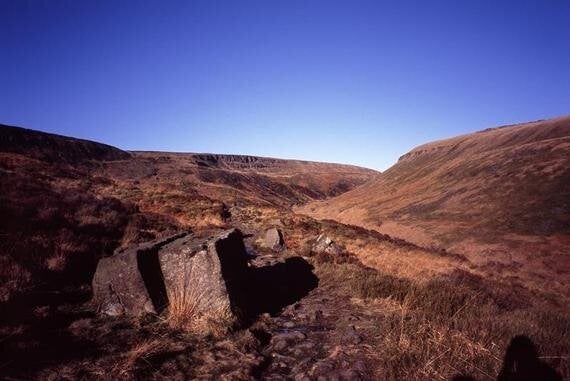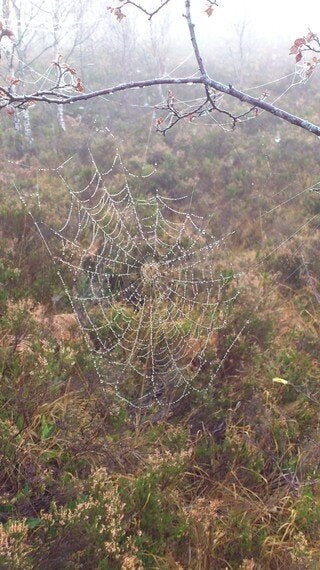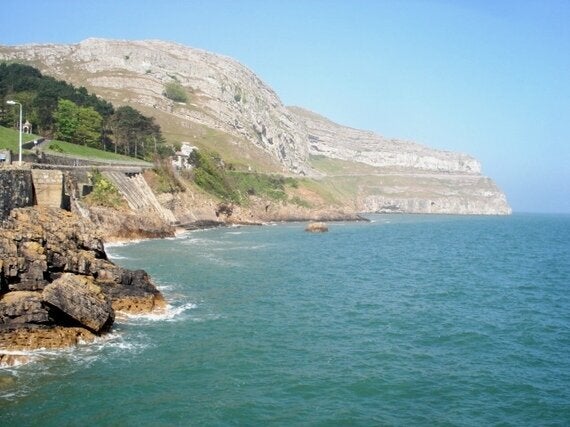With great fanfare, National Trust has recently acquired the Great Orme. With 'Orme' being Viking for serpent, we have many sea serpents in Wales, including the National Trust ones at Worm's Head in the south and Ynys Lochtyn in the middle - we now have one guarding North Wales for us. Unexpectedly, it's reminded me of my childhood and made me think about how landscapes change in their significance as we get older. It's a place that's quite close to my heart - with family in North Wales, we travelled over to Cymru from Leeds (seemingly an epic journey) regularly.
First, the stark beauty of the Pennines, with its huge purple, brown and yellow pillows under a steely sky, often shrouded in fog. To me, it was land of Cathy and Heathcliff, of seemingly the highest bridge in the world (Scammonden bridge), and my dream house, Stott Hall Farm. How could you not want to live in that house, probably the biggest house in the world, on the lovely Pennines, with all those comforting traffic sounds? This was thought entirely without sarcasm - sarcasm only works verbally as part of showing off how clever you are. You rarely meet a sardonic child, which is one of the many things that makes them better than us. The sounds of traffic through the night would comfort you when you thought the man in the wardrobe was slowly poking his hand out, so incredibly slowly, so you couldn't see him moving. Surely those cars would stop and their inhabitants would help when the vampire started tapping on the window, cars chasing away the night terrors.
A child also wonderfully lacks cynicism. I would be Cathy - she was passionate, alive, mischievous, a heroine who stood up for what she loved. Plus she had brown hair. The moors looked lonely but there was nothing scary about them - they were full of lovely, fluffy sheep and gruff, if flawed, heroes. Nothing and nobody else could possibly live there.

The Pennines: land of Cathy, Heathcliff and a whole lot of sheep on a rare sunny day Credit: http://photoeverywhere.co.uk
Then, through the urban sprawl of Greater Manchester and Cheshire, to North Wales, and The Sea. Driving along the north coast of Wales, everything seemed so much brighter and bluer than the Pennines, but far less mysterious. The sea and sand, ball pools and discos, Grandad's mushy peas and Nanna's garden where the fairies lived were fun - it was about the friends and family you were with. Sometimes, though, we'd go to Llandudno. We'd be on the beach, but we could see this huge rock, clearly the biggest in the world, where no humans could go. Here, trolls emerged over the top, mermaids basked on the rocks, a unicorn might fly overhead.
I would have built another dream house here, only a lighthouse would do, and the island would be mine (not a socialist child). I realised fairly quickly that the building would have changed the landscape for me and everyone else looking at it - whilst they couldn't visit of course, it wouldn't be fair to ruin the view (but with a strong sense of fairness). Perhaps the feathered house that hopped on one leg from A Necklace of Raindrops would have been an acceptable alternative. Come to think of it, perhaps this quote from said book is what inspired the requirement to have three over two lighthouse keepers rather than the Smalls lighthouse incident.

Necklaces of raindrops Credit: Gwen Potter
I digress. We never visited. We didn't go up on the tram like in Snowdonia, so it was always a mystery. It must have been really good though, if it was 'Great'. It was big - I knew that - probably the biggest expanse of rocks in the world, but it was empty aside from mythical creatures. There wouldn't be any seabirds like on the amazing Yorkshire coast, or at the Farne Islands. My Dad was the tallest man in the world, so when would lift me up on his shoulders, I would always think I might - just - be able to see over the top and see what was beyond. If I had, I would have found amazing landscapes, history and wonderful wildlife - often invisible to you at first glance, that have been looked after really well.
That wonderful Christmas plant, the cotoneaster, grows as a native here only. All the Christmassy Cotoneaster species in our gardens, that are supposedly fab for wildlife, are a nightmare destroying the limestone cliffs on Gower, but here the species C. integerrimus is native and adapted to the place, fitting in amongst the complex web of life on the cliffs. People of all ages will visit the Orme in the spring, when wild thyme, pyramidal orchid and thrift will carpet the headland in colour, and the rare early silver studded blues skip amongst them. Seabirds, such as razorbills, kittiwakes, fulmars, guillemots and shags, so threatened on our coasts, will start to arrive and will always have a place to nest, creating a cacophony of noise on the cliffs, just like in Yorkshire. In the rockpools, hemit crabs will shuffle, barnacles will sift, crabs will snap and deadly dog whelks will drill.

The Great Orme from Llandudno pier. Credit: Trevor Rickard on www.geograph.org.uk
Now, despite loving the Pennines still, and that wonderful, random, sore thumb farmhouse, a symbol of rebellion not unlike the Kinder Scout mass trespass, I think of different things. Awful things that happened on the moors long before I was born, how Cathy would be judged for her choices and mental illness today. More than anything, how the unique, truly spectacular upland wildlife - sundew, black grouse and hen harrier should be thriving there but aren't. How there should be some broadleaved woodland instead of all that endless blank space. I think of other places I have worked or visited - Corrimony and Dark Peak - and how they are a symbol of how our upland could be. I don't see the Orme as barren, it is full of flowers, butterflies, seabirds and at least one of my childhood places will be even more well protected.
Our memories and feelings about landscapes change, that's what makes them unique to us. I welcome the silence at night, and love the sound of a tree tapping on the window. 'Time changes it...as winter changes the trees'. Now everyone can create their own memories of the Great Orme, whether they are looking for peace and solitude and the glimpse of a seal or an orchid, or to visit with friends and go for a nice long bike ride. A child (or the young at heart) might imagine the tiniest fairy living under the tiniest flowers in the world, or glimpse a basking shark, and think of the mermaid swimming with it. Everyone will be able to visit and make it theirs, but never build a house on the highest point, and run away from trolls only in their imagination.